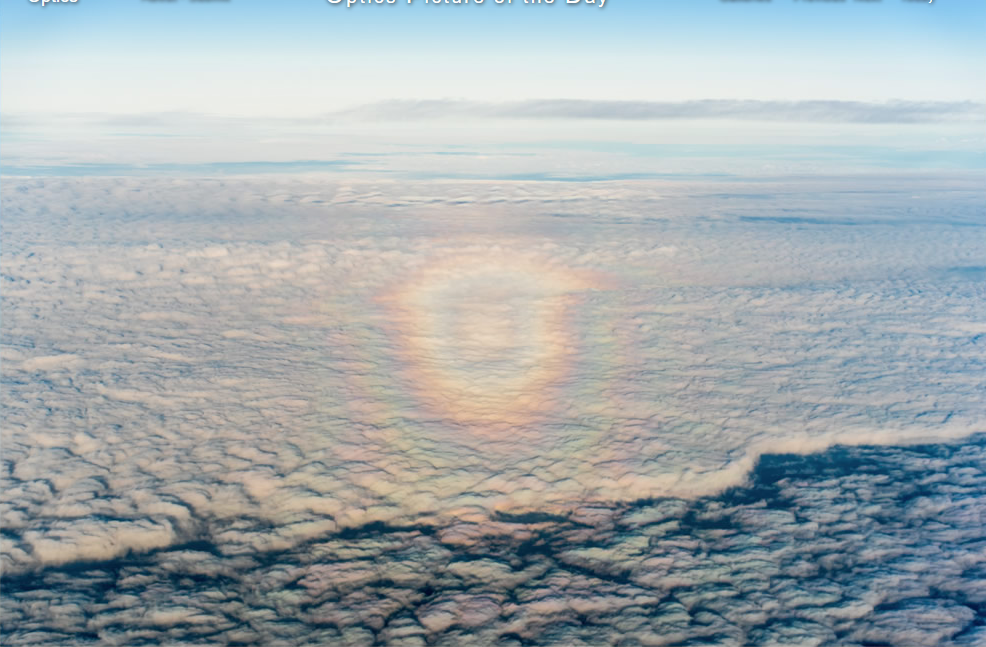Non-circular Glory - OPOD
Non-circular Glory: A Phenomenon Beyond the Ordinary
Have you ever witnessed a peculiar atmospheric phenomenon known as a non-circular glory? Zhuoxiao Wang of China had the incredible opportunity to observe this enchanting spectacle during a flight from Beijing to San Jose, high over the Alaskan skies. Unlike the traditional circular glories we are accustomed to, this one appeared split and non-circular, leaving observers in awe and wonder. But what causes this deviation from the norm?
Glories are typically circular, colored rings that encircle the antisolar point, which is opposite the position of the sun. These captivating displays are formed when sunlight is diffracted and backscattered by tiny cloud droplets. However, the non-circular glory observed by Wang is a fascinating exception to this rule. Surprisingly, it has nothing to do with the angle of the cloud deck or the shapes of individual clouds.
Unlike halos and rainbows, which maintain their characteristic appearance regardless of the positions and distances of the water droplets, ice crystals, or raindrops involved, the angular size of a glory is directly influenced by the diameters of the cloud droplets. These droplets typically range from 0.002 to 0.2 mm in diameter. Interestingly, the smallest droplets produce the largest glories, while larger droplets result in smaller glories.
On that particular day over Alaska, there was a progressive increase in mean cloud top droplet size with distance from the airplane. As a result, the glory observed by Wang exhibited a fragmented appearance, with the lowest tip being particularly prominent. This fragmentation was caused by the presence of small cloud droplets near the plane, which produced a large glory fragment.
Beyond the visible ridge or step in the cloud deck, further changes in droplet size occurred, leading to the split and flattened shape of the glory. The two tilted ellipses of clouds were responsible for sending glory light backwards to the observer's eye, while other droplets did not contribute to the phenomenon. Although the two elliptical rings of light appeared circular to the observer, they were actually ellipses. This illusion occurs because nearly all atmospheric optical phenomena, except for crepuscular rays, appear to be at infinity and are beyond our reach.
The non-circular glory captured by Zhuoxiao Wang serves as a testament to the boundless beauty and complexity of atmospheric optics. This rare phenomenon challenges our expectations and reminds us of the intricate interplay between light and the natural world. By delving deeper into the intricacies of atmospheric phenomena, we can continue to unravel the mysteries that surround us and appreciate the remarkable wonders that unfold above our heads.

Non-circular Glory
A peculiar glory seen by Zhuoxiao Wang of China on a journey from Beijing to San Jose. The aircraft was high over Alaska.
Glories are circular – always circular – coloured rings around the antisolar point opposite the sun. Tiny cloud droplets form them by individually diffracting and backscattering sunlight.
Why then is this glory non-circular and even split? It has nothing to do with the angle of the cloud deck or shapes of individual clouds. Glories, like halos and rainbows always look the same no matter the positions and distances of the water drops, ice crystals or raindrops making them.
The angular size of a glory depends on the diameters of the cloud droplets. They are 0.002 to 0.2 mm in diameter. The smallest droplets produce the largest glories and vice versa. Over Alaska that day there happened to be a progressive increase in mean cloud top droplet size with distance from the airplane. Near the plane, small drops produced a large glory fragment comprising the lowest tip of that seen.
Beyond the obvious ridge/step in the cloud deck there are further droplet size changes that make the split and then the flattened shape.
Images ©Zhuoxiao Wang, shown with permission

Two tilted clouds
And a single untilted glory.
Droplets on the two tilted ellipses are the only ones sending glory light backwards to the eye.
But to the eye both elliptical rings of light appear to be circles like the dotted one far away, actually at infinity.
Nearly all atmospheric optical phenomena, crepuscular rays are notable exceptions, are at infinity and quite untouchable.

Note: this article has been automatically converted from the old site and may not appear as intended. You can find the original article here.
Reference Atmospheric Optics
If you use any of the definitions, information, or data presented on Atmospheric Optics, please copy the link or reference below to properly credit us as the reference source. Thank you!
-
<a href="https://atoptics.co.uk/blog/non-circular-glory-opod/">Non-circular Glory - OPOD</a>
-
"Non-circular Glory - OPOD". Atmospheric Optics. Accessed on November 26, 2024. https://atoptics.co.uk/blog/non-circular-glory-opod/.
-
"Non-circular Glory - OPOD". Atmospheric Optics, https://atoptics.co.uk/blog/non-circular-glory-opod/. Accessed 26 November, 2024
-
Non-circular Glory - OPOD. Atmospheric Optics. Retrieved from https://atoptics.co.uk/blog/non-circular-glory-opod/.